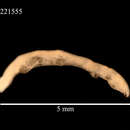Comprehensive Description
provided by Smithsonian Contributions to Zoology
Leptanthura argentinae
MATERIAL.—Holotype: USNM 185021, Sta WHOI 245, 1 ovig. , 5.9 mm. Allotype: USNM 185022, Sta WHOI 245, 1 , 7.5 mm. Paratypes: USNM 185023, Sta WHOI 245, 2 ovig. , 5.4–5.5 mm, 4 , 6.0–7.5 mm, 70 non-ovig. and juvs; ZMC: Sta WHOI 245, 1 ovig. , 5.5 mm, 1 , 7.5 mm, 5 non-ovig. . Additional material: SIO: Sta WHOI 237, 2 ovig. , 8.0–8.8 mm, 4 , 7.9–8.8 mm, 8 non-ovig. and juvs; Sta WHOI 262, 1 ovig. 6.4 mm; Sta WHOI 259, 1 ovig. , 6.0 mm, 3 , 6.5–7.0 mm, 9 non-ovig. and juvs.
DESCRIPTION.—Ovigerous Female: Integument thin, delicate, non-indurate. Proportions: C < 1 = 2 = 3 < 4 = 5 > 6 > 7. Rostrum reaching as far as rounded dorsolateral lobes of cephalon. Pleonites 1–4 subequal in length; pleonites 5 and 6 subequal, longer than preceding segments. Telson parallel-sided, with broad hyaline margin, distal margin broadly and evenly rounded; large single proximal statocyst present.
Antennular peduncle with basal segment longer and broader than three distal segments together; flagellum of four articles. Antennal flagellum of three articles. Mandibular palp with second segment twice length of first; third segment with two terminal spines. Maxilliped with obsolete endite; palp with four setose articles beyond endite. Pereopod 1 propodus with triangular proximal “thumb,” palm very slightly concave, with nine multidentate sensory spines; carpus with two sensory spines. Pereopods 2–3 propodi not as large as in pereopod 1, palm straight, with seven multidentate sensory spines; carpi with two sensory spines. Pereopods 4–7 with unguis about one-sixth length of dactylus; propodus with four spines on posterior margin; carpus with two spines. Pleopod 1 exopod operculiform; endopod slightly shorter and less than half of exopod. Uropodal exopod broadly oval, with hyaline margin fringed with plumose setae; endopod triangular, distally narrowly rounded, setose, subequal in length to basis, about half its length beyond telsonic apex.
Male: Body more elongate than in female. Antennular flagellum of 10 to 12 articles bearing whorls of fine aesthetascs. Pleonites relatively more elongate than in female. Pleopod 2 with copulatory stylet slender, cylindrical, extending beyond endopodal apex. Uropodal endopod relatively more elongate and setose than in female; exopod relatively wider than female, with longer straight margin. Telson tapering to narrowly rounded apex.
- bibliographic citation
- Kensley, Brian F. 1982. "Deep-water Atlantic Anthuridea (Crustacea, Isopoda)." Smithsonian Contributions to Zoology. 1-60. https://doi.org/10.5479/si.00810282.346
Depth range
provided by World Register of Marine Species
1002-4392
Van Wyk, B. & Malan, S. (1988) Field Guide to the Wild Flowers of the Witwatersrand and Pretoria Region Struik, Cape Town Pages 54 - 55 (Includes a picture).
- license
- cc-by-4.0
- copyright
- WoRMS Editorial Board

